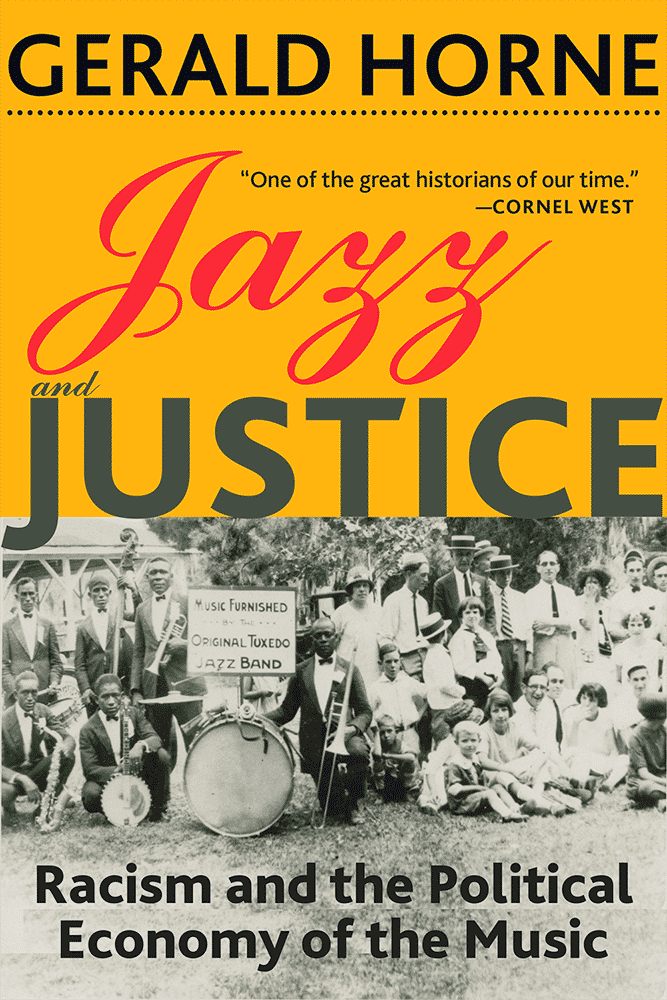Jazz and Justice: Racism and the Political Economy of the Music, by Gerald Horne (Monthly Review Press, 2019). 456 pages
Historian Gerald Horne, Chair of History and African American Studies at the University of Houston, is a prolific author and frequent guest on progressive news shows. Among his more than 30 books are The Counter-Revolution of 1776 (2014) and The Apocalypse of Settler Colonialism (2018). Both are notable works. The former challenges received ideas about the virtuous beginnings of the American republic; the latter contributes to our understanding of the construction of “white” identity in a society that was built on the labour of African slaves and bent on exterminating Indigenous peoples. With Jazz and Justice, Dr. Horne turns his attention to one of the United States’ greatest contributions to world culture: a “hot-house flower” that grew out of the muck of racist violence and brutal oppression.
The book’s sub-title suggests an analytical study of social forces, structures, and institutions. But, while Horne supplies plenty of facts and figures in Jazz and Justice, he relies more on an anecdotal approach, drawing heavily upon the oral testimonies of jazz musicians which are now deposited in university libraries across the USA. “This is a book,” he writes, “about the travails and triumphs of these talented musicians as they sought to make a living, at home and abroad, through dint of organizing – and fighting.”
Jazz musicians developed their art in nightclubs, bars, bordellos, and other venues that were close to, if not controlled by, organized crime. During the Prohibition era, every city had its Al Capone and gangs were omnipresent on the jazz scene, a situation that continued well into the post-war era. Most nightclubs were mob-controlled. There were mob-linked managers (like Louis Armstrong’s Joe Glaser), mob-linked booking agencies, and mob links to government. President Harry Truman, for example, openly acknowledged that he owed his political success to Kansas City mob boss Tom Pendergast.
From the beginning, African American musicians responded to their ruthless exploitation and dangerous workplace conditions by carrying guns and seeking mobster protection for themselves.
In later decades, self-help strategies were more positive, as African American musicians formed, albeit with mixed results, record companies (Charles Mingus and Max Roach’s Debut Records), publishing companies (Gigi Gryce’s Melotone Music), and musical associations (Chicago’s Association for the Advancement of Creative Musicians).
Most jazz artists understood the systemic nature of their oppression and developed strategies of resistance and struggle. In the early days, some were attracted to the Pan-Africanism of Marcus Garvey. By the 1930’s many had turned to the Communist Party (CPUSA) and the movements that it led, including the defense of the Scottsboro Boys. Some musicians, like trumpeter Frankie Newton, became Party members. Others were sympathizers, including Duke Ellington, who supported the successful 1943 election campaign of African American communist Ben Davis to the New York City Council. As the influence of the CPUSA declined in the Cold War era, the Nation of Islam, and later the left-wing Black Panthers attracted considerable support from jazz artists.
While Black musicians supported desegregation, many found integration a problematic concept, especially within their industry. Merging Black locals of the American Federation of Musicians with their larger White locals often had negative results for Black musicians. Horne argues that amalgamation led Black unions to erode “a base where white supremacy could be fought” while “being digested by unions where white supremacy was hardly absent.” He provides several examples, including a 1942 case, where AFM President James Petrillo condoned the exclusive use by Chicago radio stations of white musicians in their broadcasts.
Many African American jazz musicians were keen to escape Jim Crow and took advantage of employment opportunities abroad. Starting in the early 1920s they could be found working long-term engagements in cities like Shanghai and Cairo. Many found Europe to be particularly hospitable and relocated there for good, like New Orleans clarinetist-saxophonist Sydney Bechet and bebop drummer Kenny Clarke. Other leading musicians, like saxophonists Coleman Hawkins, Ben Webster and Dexter Gordon, lived in Europe for years, basking in the respect that was not accorded to African American musicians in the USA. Horne describes the effect of this diaspora as a de facto lobby for the oppressed folks back home; it built solidarity.
For the US State Department, in the era of the Cold War and an upsurge in anti-colonial struggles, jazz became a useful public relations tool. State Department tours by African American artists like Louis Armstrong and Duke Ellington were seen as an effective antidote to the negative image that America was projecting to the world in a time of heightened civil rights struggles on the home front. Another useful tool was Voice of America radio, which broadcast jazz to millions of listeners around the world. A statement by its host, Willis Conover, reminds us that fake news is old hat. “Jazz,” said Conover, “corrects the fiction that America is racist.”
Jazz and Justice is not without its downside. There are many rambling passages, with unnecessary asides, and anecdotes that belabour the point. There are several factual errors – for example, bassist Monk Montgomery is described as a guitarist, and the chronology of Fats Navarro and Miles Davis as trumpeters in the Charlie Parker Quartet is mixed up. There are also gossipy pot-shots, as when saxophonist Lou Donaldson calls drummer Art Blakey “a con man”, and Parker’s widow, Chan Parker, describes jazz impresario Norman Granz as “a screaming faggot.” Why do we need this? Finally, there is Dr. Horne’s sheer verbosity, a trait that can send the reader to the dictionary time after time. For some, like myself, this can be fun – a tune is “pulchritudinous,” and a racist bias is “obdurately obsidian.” But at times it all seems a little excessive.
Though some may find it frustrating to read, Jazz and Justice is a valuable contribution to jazz scholarship.




